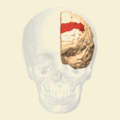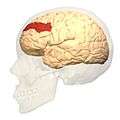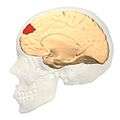Brodmann area 9
| Brodmann area 9 | |
|---|---|
 | |
 | |
| Details | |
| Identifiers | |
| Latin | Area frontalis granularis |
| NeuroLex ID | Brodmann area 9 |
| FMA | 68606 |
Brodmann area 9, or BA9, is part of the frontal cortex in the brain of humans and other primates. It contributes to the dorsolateral and medial prefrontal cortex.
Guenon
The term Brodmann area 9 refers to a cytoarchitecturally defined portion of the frontal lobe of the guenon. Brodmann-1909 regarded it on the whole as topographically and cytoarchitecturally homologous to the granular frontal area 9 and frontopolar area 10 in the human. Distinctive features (Brodmann-1905): Unlike Brodmann area 6-1909, area 9 has a distinct internal granular layer (IV); unlike Brodmann area 6 or Brodmann area 8-1909, its internal pyramidal layer (V) is divisible into two sublayers, an outer layer 5a of densely distributed medium-size ganglion cells that partially merges with layer IV, and an inner, clearer, cell-poor layer 5b; the pyramidal cells of sublayer 3b of the external pyramidal layer (III) are smaller and sparser in distribution; the external granular layer (II) is narrow, with small numbers of sparsely distributed granule cells.[1]
Functions
The area is involved in short term memory,[2] evaluating recency,[3] overriding automatic responses,[4] verbal fluency,[5] error detection,[6] auditory verbal attention,[7] inferring the intention of others,[8] inferring deduction from spatial imagery,[9] inductive reasoning,[10] attributing intention,[11] sustained attention involved in counting a series of auditory stimuli,[12] and lower levels of energy consumption in individuals suffering from bipolar disorder.[13]
The area found on the left hemisphere is at least partially responsible for empathy,[14] idioms,[15][16] processing pleasant and unpleasant emotional scenes,[17] self criticisms[18] and attention to negative emotions.[19]
On the right hemisphere the region is involved in attributing intention,[20] theory of mind,[21] suppressing sadness,[22] working memory,[23][24][25] spatial memory,[26][27] recognition,[28][29][30] recall,[29][31][32] recognizing the emotions of others,[33] planning,[34] calculation,[35][36] semantic and perceptual processing of odors,[37] religiosity,[38] and attention to positive emotions.[19]
Image
 Animation.
Animation. front view.
front view. Lateral view.
Lateral view. Medial view.
Medial view.
See also
References
- ↑
 This article incorporates text available under the CC BY 3.0 license. Archived December 7, 2013, at the Wayback Machine.
This article incorporates text available under the CC BY 3.0 license. Archived December 7, 2013, at the Wayback Machine. - ↑ Babiloni C, Ferretti A, Del Gratta C, et al. (May 2005). "Human cortical responses during one-bit delayed-response tasks: an fMRI study". Brain Research Bulletin. 65 (5): 383–90. doi:10.1016/j.brainresbull.2005.01.013. PMID 15833592.
- ↑ Zorrilla LT, Aguirre GK, Zarahn E, Cannon TD, D'Esposito M (November 1996). "Activation of the prefrontal cortex during judgments of recency: a functional MRI study". NeuroReport. 7 (15-17): 2803–6. doi:10.1097/00001756-199611040-00079. PMID 8981471.
- ↑ Kübler A, Dixon V, Garavan H (August 2006). "Automaticity and reestablishment of executive control-an fMRI study". Journal of Cognitive Neuroscience. 18 (8): 1331–42. doi:10.1162/jocn.2006.18.8.1331. PMID 16859418.
- ↑ Abrahams S, Goldstein LH, Simmons A, et al. (September 2003). "Functional magnetic resonance imaging of verbal fluency and confrontation naming using compressed image acquisition to permit overt responses". Human Brain Mapping. 20 (1): 29–40. doi:10.1002/hbm.10126. PMID 12953304.
- ↑ Chevrier AD, Noseworthy MD, Schachar R (December 2007). "Dissociation of response inhibition and performance monitoring in the stop signal task using event-related fMRI". Human Brain Mapping. 28 (12): 1347–58. doi:10.1002/hbm.20355. PMID 17274022.
- ↑ Nakai T, Kato C, Matsuo K (2005). "An FMRI study to investigate auditory attention: a model of the cocktail party phenomenon". Magnetic Resonance in Medical Sciences. 4 (2): 75–82. doi:10.2463/mrms.4.75. PMID 16340161.
- ↑ Goel V, Grafman J, Sadato N, Hallett M (September 1995). "Modeling other minds". NeuroReport. 6 (13): 1741–6. doi:10.1097/00001756-199509000-00009. PMID 8541472.
- ↑ Knauff M, Mulack T, Kassubek J, Salih HR, Greenlee MW (April 2002). "Spatial imagery in deductive reasoning: a functional MRI study". Brain Research. Cognitive Brain Research. 13 (2): 203–12. doi:10.1016/S0926-6410(01)00116-1. PMID 11958963.
- ↑ Goel V, Gold B, Kapur S, Houle S (March 1997). "The seats of reason? An imaging study of deductive and inductive reasoning". NeuroReport. 8 (5): 1305–10. doi:10.1097/00001756-199703240-00049. PMID 9175134.
- ↑ Fink GR, Marshall JC, Halligan PW, et al. (March 1999). "The neural consequences of conflict between intention and the senses". Brain. 122 (3): 497–512. doi:10.1093/brain/122.3.497. PMID 10094258.
- ↑ Shallice T, Stuss DT, Alexander MP, Picton TW, Derkzen D (2008). "The multiple dimensions of sustained attention". Cortex. 44 (7): 794–805. doi:10.1016/j.cortex.2007.04.002. PMID 18489960.
- ↑ Brooks JO, Bearden CE, Hoblyn JC, Woodard SA, Ketter TA (December 2010). "Prefrontal and paralimbic metabolic dysregulation related to sustained attention in euthymic older adults with bipolar disorder". Bipolar Disorders. 12 (8): 866–74. doi:10.1111/j.1399-5618.2010.00881.x. PMID 21176034.
- ↑ Farrow TF, Zheng Y, Wilkinson ID, et al. (August 2001). "Investigating the functional anatomy of empathy and forgiveness". NeuroReport. 12 (11): 2433–8. doi:10.1097/00001756-200108080-00029. PMID 11496124.
- ↑ Maddock RJ, Buonocore MH (August 1997). "Activation of left posterior cingulate gyrus by the auditory presentation of threat-related words: an fMRI study". Psychiatry Research. 75 (1): 1–14. doi:10.1016/s0925-4927(97)00018-8. PMID 9287369.
- ↑ Lauro LJ, Tettamanti M, Cappa SF, Papagno C (January 2008). "Idiom comprehension: a prefrontal task?". Cerebral Cortex. 18 (1): 162–70. doi:10.1093/cercor/bhm042. PMID 17490991.
- ↑ Lane RD, Reiman EM, Bradley MM, et al. (November 1997). "Neuroanatomical correlates of pleasant and unpleasant emotion". Neuropsychologia. 35 (11): 1437–44. doi:10.1016/S0028-3932(97)00070-5. PMID 9352521.
- ↑ Longe O, Maratos FA, Gilbert P, et al. (January 2010). "Having a word with yourself: neural correlates of self-criticism and self-reassurance". NeuroImage. 49 (2): 1849–56. doi:10.1016/j.neuroimage.2009.09.019. PMID 19770047.
- 1 2 Kerestes R, Ladouceur CD, Meda S, et al. (January 2012). "Abnormal prefrontal activity subserving attentional control of emotion in remitted depressed patients during a working memory task with emotional distracters". Psychological Medicine. 42 (1): 29–40. doi:10.1017/S0033291711001097. PMID 21733287.
- ↑ Brunet E, Sarfati Y, Hardy-Baylé MC, Decety J (February 2000). "A PET investigation of the attribution of intentions with a nonverbal task". NeuroImage. 11 (2): 157–66. doi:10.1006/nimg.1999.0525. PMID 10679187.
- ↑ Gallagher HL, Jack AI, Roepstorff A, Frith CD (July 2002). "Imaging the intentional stance in a competitive game". NeuroImage. 16 (3 Pt 1): 814–21. doi:10.1006/nimg.2002.1117. PMID 12169265.
- ↑ Kaur S, Sassi RB, Axelson D, et al. (September 2005). "Cingulate cortex anatomical abnormalities in children and adolescents with bipolar disorder". The American Journal of Psychiatry. 162 (9): 1637–43. doi:10.1176/appi.ajp.162.9.1637. PMID 16135622.
- ↑ Zhang JX, Leung HC, Johnson MK (November 2003). "Frontal activations associated with accessing and evaluating information in working memory: an fMRI study". NeuroImage. 20 (3): 1531–9. doi:10.1016/j.neuroimage.2003.07.016. PMID 14642465.
- ↑ Pochon JB, Levy R, Fossati P, et al. (April 2002). "The neural system that bridges reward and cognition in humans: an fMRI study". Proceedings of the National Academy of Sciences of the United States of America. 99 (8): 5669–74. Bibcode:2002PNAS...99.5669P. doi:10.1073/pnas.082111099. JSTOR 3058552. PMC 122829
 . PMID 11960021.
. PMID 11960021. - ↑ Raye CL, Johnson MK, Mitchell KJ, Reeder JA, Greene EJ (February 2002). "Neuroimaging a single thought: dorsolateral PFC activity associated with refreshing just-activated information". NeuroImage. 15 (2): 447–53. doi:10.1006/nimg.2001.0983. PMID 11798278.
- ↑ Slotnick SD, Moo LR (2006). "Prefrontal cortex hemispheric specialization for categorical and coordinate visual spatial memory". Neuropsychologia. 44 (9): 1560–8. doi:10.1016/j.neuropsychologia.2006.01.018. PMID 16516248.
- ↑ Leung HC, Gore JC, Goldman-Rakic PS (May 2002). "Sustained mnemonic response in the human middle frontal gyrus during on-line storage of spatial memoranda". Journal of Cognitive Neuroscience. 14 (4): 659–71. doi:10.1162/08989290260045882. PMID 12126506.
- ↑ Ranganath C, Johnson MK, D'Esposito M (2003). "Prefrontal activity associated with working memory and episodic long-term memory". Neuropsychologia. 41 (3): 378–89. doi:10.1016/S0028-3932(02)00169-0. PMID 12457762.
- 1 2 Rugg MD, Fletcher PC, Frith CD, Frackowiak RS, Dolan RJ (December 1996). "Differential activation of the prefrontal cortex in successful and unsuccessful memory retrieval". Brain. 119 (6): 2073–83. doi:10.1093/brain/119.6.2073. PMID 9010011.
- ↑ Tulving E, Habib R, Nyberg L, Lepage M, McIntosh AR (1999). "Positron emission tomography correlations in and beyond medial temporal lobes". Hippocampus. 9 (1): 71–82. doi:10.1002/(SICI)1098-1063(1999)9:1<71::AID-HIPO8>3.0.CO;2-F. PMID 10088902.
- ↑ Tulving E, Kapur S, Markowitsch HJ, Craik FI, Habib R, Houle S (March 1994). "Neuroanatomical correlates of retrieval in episodic memory: auditory sentence recognition". Proceedings of the National Academy of Sciences of the United States of America. 91 (6): 2012–5. Bibcode:1994PNAS...91.2012T. doi:10.1073/pnas.91.6.2012. JSTOR 2364162. PMC 43299
 . PMID 8134341.
. PMID 8134341. - ↑ Düzel E, Picton TW, Cabeza R, et al. (June 2001). "Comparative electrophysiological and hemodynamic measures of neural activation during memory-retrieval". Human Brain Mapping. 13 (2): 104–23. doi:10.1002/hbm.1028. PMID 11346889.
- ↑ Bermpohl F, Pascual-Leone A, Amedi A, et al. (August 2006). "Attentional modulation of emotional stimulus processing: an fMRI study using emotional expectancy". Human Brain Mapping. 27 (8): 662–77. doi:10.1002/hbm.20209. PMID 16317710.
- ↑ Fincham JM, Carter CS, van Veen V, Stenger VA, Anderson JR (March 2002). "Neural mechanisms of planning: a computational analysis using event-related fMRI". Proceedings of the National Academy of Sciences of the United States of America. 99 (5): 3346–51. Bibcode:2002PNAS...99.3346F. doi:10.1073/pnas.052703399. JSTOR 3058122. PMC 122521
 . PMID 11880658.
. PMID 11880658. - ↑ Xie S, Xiao J, Jiang X (June 2003). 正常老年人计算任务的脑功能磁共振成像研究 [The fMRI study of the calculation tasks in normal aged volunteers] (PDF). Journal of Peking University (in Chinese). 35 (3): 311–3. PMID 12914254.
- ↑ Rickard TC, Romero SG, Basso G, Wharton C, Flitman S, Grafman J (2000). "The calculating brain: an fMRI study". Neuropsychologia. 38 (3): 325–35. doi:10.1016/S0028-3932(99)00068-8. PMID 10678698.
- ↑ Royet JP, Koenig O, Gregoire MC, et al. (January 1999). "Functional anatomy of perceptual and semantic processing for odors". Journal of Cognitive Neuroscience. 11 (1): 94–109. doi:10.1162/089892999563166. PMID 9950717.
- ↑ Azari NP, Nickel J, Wunderlich G, et al. (April 2001). "Neural correlates of religious experience". The European Journal of Neuroscience. 13 (8): 1649–52. doi:10.1046/j.0953-816x.2001.01527.x. PMID 11328359.
External links
| Wikimedia Commons has media related to Brodmann area 9. |
- Gusnard, Debra A.; Akbudak, Erbil; Shulman, Gordon L.; Raichle, Marcus E. (March 27, 2001). "Medial Prefrontal Cortex and Self-Referential Mental Activity: Relation to a Default Mode of Brain Function". Proceedings of the National Academy of Sciences of the United States of America. 98 (7): 4259–64. Bibcode:2001PNAS...98.4259G. doi:10.1073/pnas.071043098. JSTOR 3055404. PMC 31213
 . PMID 11259662.
. PMID 11259662. - https://web.archive.org/web/20141104204919/http://www.skiltopo.com/1/index.htm#BA9L[]
- For Neuroanatomy of this area see BrainInfo